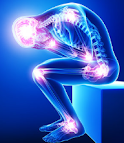Some Anatomy on Postoperative Pain
Nociception is the neural processing of injurious stimuli in response to tissue damage ( 2023). Nociception starts at the sensory receptors; however, the perception does not start until the brain gets the signal. There are several of these nociceptive pathways that lead to the brain. Most axons (which are nerve fibers that conduct electrical impulses) that carry nociceptive information to the brain from the spinal cord project to the thalamus. Their final processing takes place in the primary somatosensory cortex. There is one nociceptive pathway that projects directly to the hypothalamus in the forebrain. This area modulates the cardiovascular and neuroendocrine functions of the autonomic nervous system. This pathway is responsible for stimulating the sympathetic branch of the visceral sensory system, which gives you a fight-or-flight response (2023).
Afferent neural pathways mediate the sensation of pain. Acute post-surgical pain has three categories
- nociceptive
- occurs in response to stimuli such as direct intraoperative tissue injury (Horn & Kramer 2022).
- inflammatory
- This pain occurs when the nociceptive fibers become sensitized which is in response to the release of inflammatory mediators such as cytokines and can last hours to days.
- neuropathic
- This pain is more chronic and it results from injury to neuronal structures.
.
Postoperative pain is characterized as somatic or visceral.
- Somatic pain is the type of pain you feel in your skin, muscles, joints, and bones. 1 It can feel like a gnawing, aching, cramping or sharp.
- Visceral pain comes from your organs
The goal for pain management aims to target the afferent pain pathways by different mechanisms such as antagonizing pain receptor activity or blocking the production of proinflammatory mediators
- Approximately 75 percent of patients who undergo surgery experience acute postoperative pain, which is often medium-high in severity (Horn & Kramer, 2022).
- Less than half of patients undergoing surgery report adequate postoperative pain relief.
"Inadequate postoperative pain control may lead to adverse physiologic effects among patients in the immediate postoperative period and places them at increased risk of developing chronic pain associated with the procedure (Horn & Kramer, 2022).
- Severe persistent postoperative pain affects 2 to 10 percent of adults.
References
Horn, R., & Kramer, J. (2022, September 19). Postoperative Pain Control. PubMed; StatPearls Publishing. https://www.ncbi.nlm.nih.gov/books/NBK544298/
(2023). Vitalsource.com. https://bookshelf.vitalsource.com/reader/books/9781938168093/pageid/377










